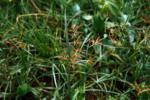Latin name
Cyperus rotundus L.
Family
Cyperaceae
Common name(s)
Purple nutsedge, umbrella sedge, nutgrass, and rice flatsedge
Synonym(s)
Chlorocyperus rotundus (L.) Palla, C. bicolor Vahl, C. maritimus Bojer
Geographical distribution
Asia: China (including Taiwan), Japan, and Korea.
South and Southeast Asia: Bangladesh, Bhutan, Brunei, India, Indonesia, Lao PDR, Malaysia, Myanmar, Nepal, Pakistan, Philippines, Sri Lanka, Thailand, and Vietnam.
Rest of the world: Afghanistan, Australia, Bermuda, Brazil, Chile, Colombia, Cote d'Ivoire, Cuba, Egypt, Ethiopia, France, Fiji, Germany, Ghana, Greece, Iran, Iraq, Jamaica, Jordan, Kenya, Madagascar, Mexico, Mozambique, New Zealand, Nigeria, Papua New Guinea, Peru, Portugal, Puerto Rico, Samoa, Somalia, Spain, Saudi Arabia, Sudan, Suriname, Swaziland, Tanzania, Tonga, Turkey, Uganda, United States, Uruguay, Venezuela, and Zambia.
Morphology
An erect perennial; 30—70—cm—tall.
Stem: erect, smooth, sharply triangular, slender and thickened at base; rhizomes wiry, black, and bear irregularly-shaped tubers.
Leaf: linear/lanceolate, shorter than the flowering stem; 10—60—cm—long.
Inflorescence: simple or compound umbel composed of 3—9 unequal rays about 2—10—cm—long; spikes 1—40 (—100) flowered; spikelets reddish brown and flat, sessile, and about 1—3—mm—long.
Fruit: brownish to black achene or nut; obovate, triangular in cross-section and 1—1.5— mm in length.
Biology and ecology
Propagated by tubers. Shoot extends and swells to form basal bulb; basal bulb produces about 3 to 4 rhizomes; aerial shoots take about 3 to 8 weeks to develop from emergence to flowering.
Tubers and rhizomes are capable of producing extensive chains; tubers can be dormant; pruning or cutting the shoots can break dormancy.
Found in wet and dry conditions; also grows in wastelands and upland crops.
Agricultural importance
One of the world's worst weeds, causing serious yield losses and difficult to control. Tubers have variable dormancy and are able to survive drought and flooding. Serves as an alternate host of diseases such as Pyricularia oryzae, Rhizoctonia solani, Thanatephorus cucumeris, and Xanthomonas campestris pv. oryzae, and the insect pests Cicadulina bipunctata (Melichar), Creatonotus gangis Linnaeus, Euscyrtus concinnus (de Haan), Haplothrips ganglbaueri Schmutz, Leptocorisa acuta (Thunberg), Mythimna separata (Walker), Nephotettix virescens (Distant), Nisia carolinensis Fennah, Nymphula depunctalis (Guenee), Recilia dorsalis (Motschulsky), Scirpophaga incertulas (Walker), and S. innotata (Walker), and nematodes Hirschmanniella sp. and Meloidogyne spp.
Management
Cultural control: difficult to control by cultivation alone because of the variable and extended dormancy of tubers. Deep plowing, repeated tillage or soil disturbance under upland conditions, and flooding of lowland rice fields can be effective means to suppress populations.
Biological control: tortricid Bactra spp. are promising biological agents.
Chemical control: systemic herbicides such as imazapyr and glyphosate can be effective.
Selected references
De Datta SK, Moody S, Sankaran S. 1986. Integrated weed management practices for upland rice. In: Progress in upland rice research. Manila (Philippines): International Rice Research Institute. p 447-460.Galinato MI, Moody K, Piggin CM. 1999. Upland rice weeds of South and Southeast Asia. Manila (Philippines): International Rice Research Institute. 156 p.Holm LG, Plucknett DL, Pancho JV, Herberger P. 1979. The world's worst weeds: distribution and biology. Honolulu, Hawaii (USA): University of Hawaii Press. 609 p.Moody K. 1989. Weeds reported in rice in South and Southeast Asia. Manila (Philippines): International Rice Research Institute. 442 p.Moody K, Munroe CE, Lubigan RT, Paller Jr. EC. 1984. Major weeds of the Philippines. College, Laguna (Philippines): Weed Science Society of the Philippines. University of the Philippines at Los Baños. 328 p.Pancho JV, Obien SR. 1995. Manual of ricefield weeds in the Philippines. Muñoz, Nueva Ecija (Philippines): Philippine Rice Research Institute. 543 p.
Contributors
JLA Catindig, RT Lubigan, and DE Johnson
